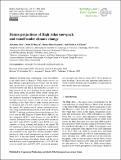| dc.contributor.author | Tuel, Alexandre | |
| dc.contributor.author | El Moçayd, Nabil | |
| dc.contributor.author | Hasnaoui, Moulay Driss | |
| dc.contributor.author | Eltahir, Elfatih AB | |
| dc.date.accessioned | 2023-03-14T17:45:46Z | |
| dc.date.available | 2023-03-14T17:45:46Z | |
| dc.date.issued | 2022 | |
| dc.identifier.uri | https://hdl.handle.net/1721.1/148547 | |
| dc.description.abstract | <jats:p>Abstract. The High Atlas, culminating at more than 4000 m, is the water tower of Morocco. While plains receive less than 400 mm of precipitation in an average year, the mountains can get twice as much, often in the form of snow between November and March. Snowmelt thus accounts for a large fraction of the river discharge in the region, particularly during spring. In parallel, future climate change projections point towards a significant decline in precipitation and enhanced warming of temperature for the area. Here, we build on previous research results on snow and climate modelling in the High Atlas to make detailed projections of snowpack and river flow response to climate change in this region. We develop end-of-century snowpack projections using a distributed energy balance snow model based on SNOW-17 and high-resolution climate simulations over Morocco with the MIT Regional Climate Model (MRCM) under a mitigation (RCP4.5) and a business-as-usual (RCP8.5) scenario. Snowpack water content is projected to decline by up to 60 % under RCP4.5 and 80 % under RCP8.5 as a consequence of strong warming and drying in the region. We also implement a panel regression framework to relate runoff ratios to regional meteorological conditions in seven small sub-catchments in the High Atlas. Relative humidity and the fraction of solid-to-total precipitation are found to explain about 30 % of the inter-annual variability in runoff ratios. Due to projected future atmospheric drying and the associated decline in snow-to-precipitation ratio, a 5 %–30 % decrease in runoff ratios and 10 %–60 % decrease in precipitation are expected to lead to severe (20 %–70 %) declines in river discharge. Our results have important implications for water resources planning and sustainability of agriculture in this already water-stressed region.
</jats:p> | en_US |
| dc.language.iso | en | |
| dc.publisher | Copernicus GmbH | en_US |
| dc.relation.isversionof | 10.5194/HESS-26-571-2022 | en_US |
| dc.rights | Creative Commons Attribution 4.0 International license | en_US |
| dc.rights.uri | https://creativecommons.org/licenses/by/4.0/ | en_US |
| dc.source | Copernicus Publications | en_US |
| dc.title | Future projections of High Atlas snowpack and runoff under climate change | en_US |
| dc.type | Article | en_US |
| dc.identifier.citation | Tuel, Alexandre, El Moçayd, Nabil, Hasnaoui, Moulay Driss and Eltahir, Elfatih AB. 2022. "Future projections of High Atlas snowpack and runoff under climate change." Hydrology and Earth System Sciences, 26 (3). | |
| dc.contributor.department | Massachusetts Institute of Technology. Department of Civil and Environmental Engineering | en_US |
| dc.relation.journal | Hydrology and Earth System Sciences | en_US |
| dc.eprint.version | Final published version | en_US |
| dc.type.uri | http://purl.org/eprint/type/JournalArticle | en_US |
| eprint.status | http://purl.org/eprint/status/PeerReviewed | en_US |
| dc.date.updated | 2023-03-14T17:29:46Z | |
| dspace.orderedauthors | Tuel, A; El Moçayd, N; Hasnaoui, MD; Eltahir, EAB | en_US |
| dspace.date.submission | 2023-03-14T17:29:53Z | |
| mit.journal.volume | 26 | en_US |
| mit.journal.issue | 3 | en_US |
| mit.license | PUBLISHER_CC | |
| mit.metadata.status | Authority Work and Publication Information Needed | en_US |
